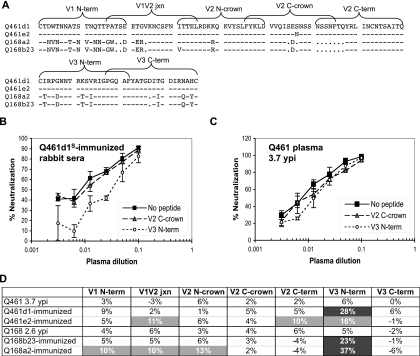FIG. 3.
Contribution of antibodies to the V1, V2, and V3 loops to the neutralizing potential of plasma from HIV-1-infected subjects and serum samples from rabbits immunized against the Q461d1S pseudovirus. (A) Amino acid alignment of the V1V2 loops (top) and V3 loops (bottom) for the four Env variants used as immunogens is shown. The location of the 20-mer peptides used for peptide competition neutralization assays are indicated by the brackets above the sequence; the sequences were made to match the Q461e2R variant, which is identical to the Q461d1S sequence, except of a single amino acid within the V2 C crown. Dashes indicate that the same amino acid was present at that position, and dots indicate a deletion of an amino acid at that position. (B) Example of representative neutralization curves depicting a decrease in neutralization by preincubation of serum samples from Q461d1S-immunized rabbits with V3 N-terminal, but not V2 C-crown, peptide. (C) Example of representative neutralization curves depicting minimal reduction in neutralization by preincubation of plasma from subject Q461 at 3.7 ypi with V2 C-crown and V3 N-terminal peptides. (D) The plasma or serum sample indicated in the far left column were preincubated with the peptide indicated along the top before the addition of the Q461d1 pseudovirus in a TZM-bl neutralization assay. The percentage of contribution of the indicated peptide to the neutralizing activity of that serum or plasma sample is indicated in the table. Increasing contribution to neutralizing activity is indicated by darker shaded boxes. Unshaded boxes indicate <5% contribution of that epitope to neutralizing activity.

